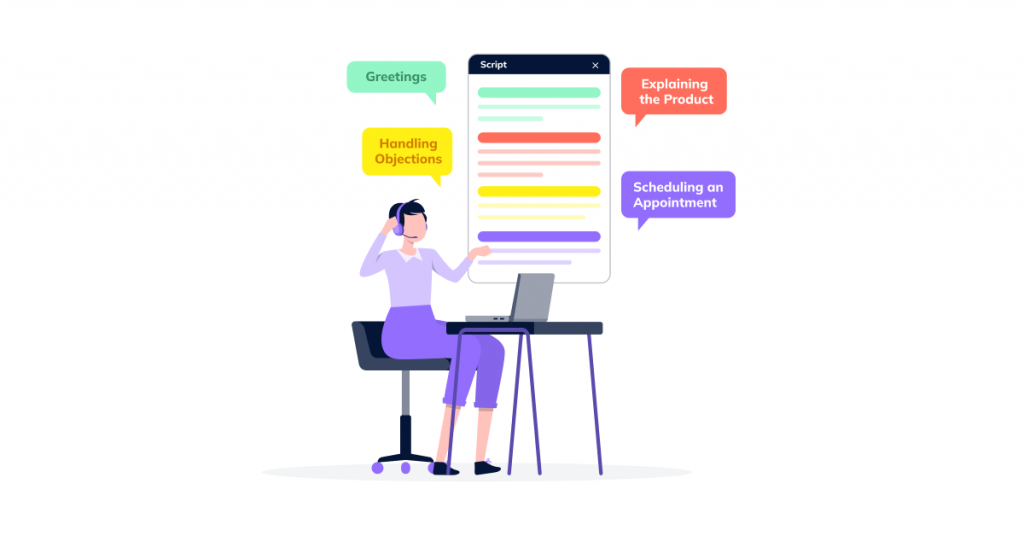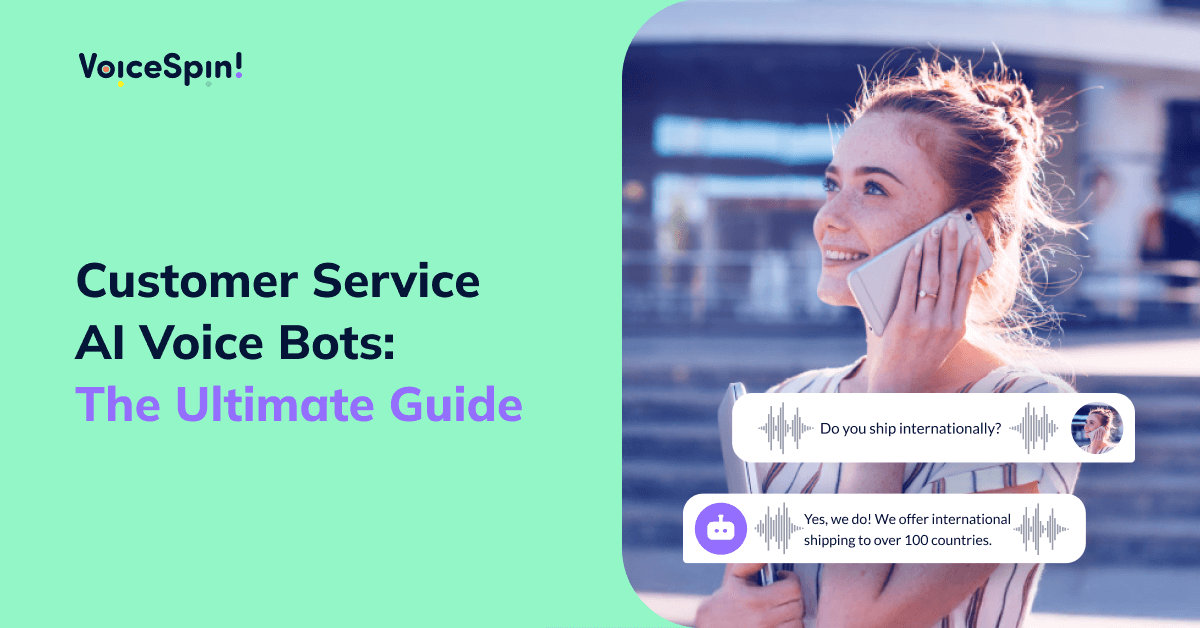Handling outbound sales calls – especially cold ones – has always been challenging for sales agents, no matter how experienced they are. Having to deal with objections, rejection, or sometimes simply not knowing what to say next – every outbound sales rep has been there. No wonder 63% of salespeople consider cold calling the worst part of their job, according to LinkedIn.
Luckily, you can make sales calling less stressful for your team members by equipping them with well-crafted outbound call center scripts. Having sales call scripts at hand when making outbound calls helps your team stay focused and more confident, helping you improve call outcomes – more demos scheduled, meetings booked, or follow-ups secured.
In this blog, we’ve come up with some ready-made outbound calling script examples along with the best practices on how to use them effectively in your cold outreach or lead nurturing calling campaigns.
What is an Outbound Call Center Script?
Getting back to the basics, an outbound calling script is a pre-written guide used by agents when making outbound calls. An outbound sales call script provides a structured framework to help sales agents communicate with prospects effectively, convey key messages consistently, and handle common objections with ease and greater confidence.
While outbound call center software optimizes the process of placing outbound phone calls, call center scripts help ensure your reps know exactly what to say in every possible scenario when making cold calls to prospects. That helps build trust and rapport with potential customers, leading to better success of your calling campaigns.
Additionally, scripts can include necessary legal disclaimers and compliance-related information, ensuring that your reps adhere to compliance guidelines. Having scripts readily available is particularly helpful when your sales team uses auto dialer software, which means they are literally handling calls one after another and can simply forget to mention important information related to compliance.
To sum it up, efficient usage of call center scripts results in:
- Improved agent confidence
- Reduced anxiety and stress
- Better handling of objections
- Consistency in messaging
- Legal and compliance assurance
Outbound Script Examples for Various Scenarios
Let’s now take a look at some outbound call script examples you can get inspired by when crafting sales scripts for your own sales team.

Appointment setting call script example
Appointment setting is one of the most common cold-calling objectives, whether it’s scheduling a demo of your product or a sales presentation for a prospect to learn more about what you have to offer and how exactly they can benefit from using your solution. The goal is to move your prospect from the awareness stage to the interest stage.
This is where you are most likely to encounter one of the most common sales objections like price concerns, bad timing, lack of need, competitor comparison, or lack of trust. Make sure you are well-prepared to handle different types of objections that might come along your way.
Here’s a great sales call script example you can rely on:
Hi [Prospect Name], this is [Your Name] from [Your Company Name]. How have you been?
We haven’t had a chance to talk directly yet. The reason for my call is that we’ve been helping companies like yours with [specific solution], and I thought it might be valuable to you. Do you have a few minutes to discuss this?
[Prospect agrees]
Excellent. To give you a bit more context, [Your Company] specializes in [briefly describe your product/service], which is why I wanted to reach out to you directly. Our solution has helped businesses like yours achieve [specific outcomes]. I’d love to show you more with a 20-minute [demo or presentation] how it works and how your business can benefit from using [your product/ service]. Would you be available sometime this week or next?
[Scenario 1: Prospect agrees]
Great, if I can get your email address, I can send you a calendar invite so you can pick a time that works best for you. Before we wrap up, is there anyone else from your team who would benefit from joining this call?
[Scenario 2: Prospect rejects for no particular reason]
No worries [Prospect Name]. I’d love to email you some additional information for future reference, so if you have a need for our product later, you’ll have it readily available. What’s the best email to reach you at?
[Scenario 3: Prospect has budget-related objections]
I completely understand that. Budget is an important consideration for every business. But one thing to consider is the potential return on investment. In fact, our customers similar to your business see on average [mention a specific outcome like increased sales by X%, improved efficiency, reduced costs by X%, etc.]. Over time, the benefits/ savings can more than justify the initial investment.
[Scenario 4: Prospect is happy with current provider]
I appreciate your loyalty to your current provider. Actually, it’s always reassuring to know that your needs are being met. But let me tell you that many of our customers have chosen to switch to us because [specific reasons why they switched to your solution]. Would you like to explore how we compare to your current solution?
[Scenario 5: Prospect doesn’t have an immediate need]
I totally understand that [Prospect Name]. What I can tell you is that many of our clients felt the same way until they experienced [X challenge]. Our solution helped them [achieve a specific outcome] and overcome this challenge. Do you currently experience [X challenge] as well?
Discovery call script example
A discovery call is an important step in the lead qualification process. It can help you evaluate and identify promising leads who are most likely to convert into customers. By asking the right open-ended questions during a discovery call, you can gather additional information about your prospects to better understand their pain points, the challenges they are facing in their business, and the goals they are trying to achieve. Armed with this information, you can tailor your sales pitch accordingly or simply find out if that prospect is a good fit for your product or service in the first place.
This discovery sales call script example might get you started in the right direction:
Hi [Prospect Name], this is [Your Name] from [Your Company Name].
Thank you for taking the time to speak with me today. I’m excited to learn more about you and your business. First of all, I speak a lot with folks in X roles in the Y industry, and I hear a lot about Z challenges. Do you also face that challenge? How does that impact your business operations?
Examples of other questions to ask:
- Are you currently using any solution to tackle that challenge?
- How long have you been using this solution?
- What are the strengths and weaknesses of your current solution?
- What are the key criteria you consider when choosing a new [product/service]?
- Who else is involved in the decision-making process?
- Are you currently evaluating any other solutions or vendors?
Voicemail script example
When cold calling your prospects, you won’t always be able to reach them on the first try. Statistically, nearly 80% of all cold calls end up going to voicemail. That’s why having an effective outbound sales script for voicemail is essential. Make sure to provide the most critical information without revealing too much, leave your contact details, and encourage the prospect to call you back. Most importantly, keep it short. According to research by InsideSales, the optimal voicemail length is 18 to 30 seconds, while every additional second after 30 causes a decrease in response rate by 2%.
Here’s a great voicemail message script example:
Hi, this is [Your Name] from [Your Company Name].
I’m sorry I didn’t get a chance to speak with you directly, but I’d love to discuss how we’ve helped companies just like yours generate 2X leads with our solution within 3 months. Feel free to call me back on [your phone number], and I’d be happy to tell you how we can do the same for your company. I understand you are busy, so if I don’t hear from you I will follow up later next week.
Looking forward to hearing from you. Have a great day!.
Voicemail follow-up script example
Leaving voicemails is an excellent way to reach out to your prospective customers and get your message across even when they don’t answer your calls. However, considering that nearly 90% of first-time voicemails are never returned, you should always have a plan to follow up several times if you don’t receive a return call from your prospect. According to statistics published by Cognism, you have a better chance of getting a response from your prospects if you leave at least three voicemails.
Here’s an effective call script example for following up on a voicemail message:
Hi again, this is [Your Name] from [Your Company Name].
I can’t seem to catch you! Anyway, I’m following up on a message I left you a few days ago. I was hoping we could connect and discuss how our solution can help you generate 2X leads within several months just like it did for similar companies. Let’s hop on a quick call to discuss more. Here’s my number [your phone number].
Thanks, and I hope to connect with you soon. Bye.
Sales call script example to get past the gatekeeper
Ideally, when making outbound sales calls, you’ll want to get in touch with decision-makers. But that is not always the case, unfortunately. Very often, your prospects will have someone to filter inbound calls and restrict direct access to them. That person is known as a ‘gatekeeper’, and it could be an associate, office manager, or personal assistant. Since your goal is to reach the decision-maker, you need to know how to maneuver around gatekeepers effectively. In situations like this, your objective is to be forwarded to the decision-maker or get their direct contact details.
The following sales script template might be helpful:
Hi, my name is [Your Name] and I’m calling from [Your Company Name].
I was hoping you could direct me to the right person. I’m trying to connect with someone who manages your [department/ job function] regarding [specific reason, e.g., how your product/ service can help them achieve specific outcomes]. Could you tell me who that might be?
[Gatekeeper names person]
Excellent. If possible, I would like to get in touch with [Decision-maker’s Name]. Could you let me know the best way to reach them?
Referral sales call script example
Typically, outbound sales calls are cold, which means you’re a complete stranger to the prospects you are calling. However, mentioning a mutual connection or referral can make you seem much more trustworthy in your prospect’s eyes and help you bridge the gap between you and a prospective customer, build rapport faster, and improve the outcome of the conversation. According to LinkedIn stats, leading with a common connection can increase the likelihood of an appointment by 70%.
When you are reaching out to a prospect through a referral or a shared connection, the following script might be helpful:
Hi [Prospect Name], this is [Your Name] from [Your Company Name].
The reason for my call today is that we recently helped [Referral’s Name/Company] with [the specific benefit they achieved by using your solution], and they thought you might also be interested in learning more about how we could help you achieve the same.
I’d love to show you more with a quick demo. Are you available early next week for a 15-minute demo call so I can tell you more about our solution and how you can benefit from it?
Promotional sales call script example
Whether B2C or B2B, consumers love to take advantage of good deals that can get them more for less. Even if you’re calling prospects for the very first time, coming up with a special offer or a limited-time deal is an effective sales tactic you can use in your outbound calling campaigns. It can help you immediately grab your prospects’ attention, build FMO (the fear of missing out), and speed up the entire sales process. Based on stats published by TrustPulse, 60% of shoppers say that FOMO has influenced their buying decisions.
Here’s an example of a promotional call script you can use to move your prospective customers faster through the sales funnel to the decision stage:
Hi [Prospect Name], this is [Your Name] from [Your Company Name]. How are you today?
I’m calling because we have an exciting limited-time promotion that I think you might be interested in. We are offering a special deal [free trial, discount, free consultation, etc.] to help businesses like yours benefit from [the benefits of taking advantage of the special offer]. Your timing couldn’t be better! Would you be interested in learning more about this offer?
[Scenario 1: Prospect rejects without reason]
No worries [Prospect Name]. I’d love to get your email address and send you some additional details in case you change your mind.
[Scenario 1: Prospect agrees]
Fantastic! What is the best email to reach you at? I can send you all the details of the special offer and the link to [sign up, redeem, etc.] to get the ball rolling.
[Scenario 1: Prospect is happy with current solution]
I totally understand and respect that, [Prospect Name]. But let me tell you that this special offer is a great [zero-commitment or no-risk] opportunity to learn more about why our solution might be a better fit for your businesses compared to your current one.
Warm sales call script example
Unlike cold calling, warm calling involves reaching out to potential leads who have already shown at least some level of interest or awareness of your brand, products, or services. These are the leads who might have downloaded your e-book or whitepaper, attended your webinar, interacted with your company on social media, signed up for your trial, or interacted with your brand in any other way. Warm calls are typically easier to make as you are less likely to get bold rejections from your prospects. On top of that, warm calls have a success rate of up to 30% compared to only 2% for cold calls, based on research from LinkedIn. Here’s a simple warm call script example:
Hi [Prospect Name], this is [Your Name] calling from [Your Company Name]. How have you been?
I’m reaching out because I noticed you recently [downloaded our whitepaper, attended our webinar, etc.], so I wanted to follow up and see if you had any questions. In fact, I think [Prospect’s Company Name] could really benefit from our [product/ service] because [list specific outcomes a prospect can achieve by using your product]. How about a quick demo call sometime this or next week to discuss this further?
Follow-up call sales script example
If you’ve already reached out to a sales lead through an alternative channel like an email or social media, but haven’t received a reply, calling them can be a great way to re-engage them and earn their attention. In fact, 60% of customers often say ‘no’ four times before finally saying yes. And according to stats from Yesware, 80% of sales deals require five or more follow-ups after the initial contact to close.
Use this follow-up outbound sales call script example to reach a prospect you’ve interacted with through a different channel:
Hi [Prospect Name], this is [Your Name] from [Your Company Name]. How have you been?
I reached out to you via email last week about how [your product/ service] can help your business achieve [specific outcome]. I’ve been wondering if you’ve had a chance to read it.
As I mentioned in my message, our company specializes in [your product/service], which I believe your company could undoubtedly benefit from. I’d love to show you more with a quick demo. Are you available on [date and time] for a 15-minute demo call?
Post-conversation call script example
Even if you’ve successfully landed an appointment with your prospect, presented your sales pitch, and were able to show them your product demo, you’ll definitely want to follow up and try to move them closer to finalizing the purchase. Besides, prospects might still have doubts whether your product or service is a worthwhile investment, so giving them a follow-up call is your chance to address their concerns once again and reassure them of the value they are going to get from using your solution.
When a prospect seems to be hesitating, this outbound sales call script might be helpful:
Hi [Prospect Name], this is [Your Name] from [Your Company Name]. How’s your day going so far?
Based on our [demo/ presentation], [Your Company’s Name]’s [Product/Service] is a great fit for your needs, and I’d like to get us moving to the next stage in the process. Typically, we [send a quote/ proposal, contract, etc.] to give you a comprehensive understanding of our offering. Is that something you’re ready for?
[Scenario 1: Prospect is not ready for the next step]
No worries and no rush, [Prospect Name]. I’ll follow up in about a month and see if anything changes at your end. In the meantime, feel free to get in touch with me if you have any questions, need any additional information, or if you’re ready to move forward.
[Scenario 2: Prospect is ready to proceed]
Fantastic! I’ll [describe the next steps] so we can get everything moving. If you have any questions or concerns in the meantime, please don’t hesitate to reach out.
Last attempt follow-up voicemail script
With only 2% of sales happening during the first point of contact, 44% of salespeople give up after the first follow-up attempt. While following up with prospects multiple times is a good idea – on the other hand, if you’ve been chasing the prospect for months and got no response at all after several attempts, it might be just about time to let them go.
So instead of chasing dead leads and wasting time and effort that you could have otherwise spent on more promising leads, simply leave a final voicemail message that might sound something like:
Hi [Prospect Name], this is [Your Name] from [Your Company Name].
I’ve left a couple of messages over the past few weeks and haven’t heard back. I understand you’re busy and might have missed them. But I wanted to make one more attempt to get in touch with you before I close your file.
Based on my research, I believe our solution can help your business tackle [challenge or pain point]. If you’re skeptical, I’d be happy to schedule a demo and answer any questions you might have. You can reach me on [your phone number] whenever you find the time. I look forward to hearing from you. Have a great day!
Best Practices for Creating Outbound Call Center Scripts
Start with a strong opening statement
Your opening statement makes a first impression on a prospect – make sure it’s a good one! First of all, clearly state who you are and what company you are with. Additionally, data from Gong.io shows that opening a sales call with ‘How have you been?’ can increase your success rate by 10%, while using ‘Did I catch you at a bad time?’ can reduce your chances of setting a meeting with a prospect by 40%. At the same time, opening a cold call by stating the reason for calling has the potential to increase your success rate by over 2x times.
For insights on the optimal times to make cold calls and maximize your outreach efforts, check our guide on the best times to cold call prospects in 2024.
Focus on what’s in it for them
When crafting your cold calling scripts, focus more on what value your product or service can bring to your prospects rather than what it does. A sales call – especially if you’re calling prospects for the first time – should grab their attention. How? By simply telling them how your solution can solve their challenges or address their pain points, how it can improve their business processes, or what outcomes they can expect to achieve from using your product or service. You can also share quick success stories of how your solution already helped similar businesses, which helps build more trust and credibility.
Remember that less is more
Your outbound call scripts don’t have to be long. Based on research by Gong.io, the highest converting talk-to-listen ratio on B2B sales calls is approximately 43:57. It basically means that tops performing sales reps speak less than half of the time. While that talk-to-listen ratio refers to successfully progressing deals to the next stage in the sales cycle, be ready to listen and have your prospects speak even if you are calling them for the first time, which brings us to the next point of asking open-ended questions.
Make a list of open-ended questions
Instead of asking straightforward yes/no questions, ask more open-ended questions that encourage a more in-depth conversation and allow you to better understand the needs of your prospects, their current processes, and the challenges their business is currently facing. This is how you uncover valuable information about your prospective customers that you can use to better tailor your offering and make sure it fits their specific needs. Open-ended questions are particularly helpful for discovery sales calls.
Be prepared to handle objections
Whether it’s bad timing (‘Now isn’t a good time to discuss this’), lack of need (‘We don’t see a need for your product’), lack of budget (‘We are already using a cheaper alternative’), or lack of authority (‘I’ve never heard of your company’) – objections are inevitable on sales calls. Making a list of the most common objections and having effective and persuasive answers ready is always helpful. Preparing for objections in advance allows you to respond more confidently and sound more professional, helping you build rapport faster and increase trust with prospects.
Include a clear call to action
When writing your outbound call scripts, think about an effective closing, which is just as important as your opening statement. An effective closing of an outbound sales call isn’t only about ending a conversation on a positive note. It’s more about setting clear expectations for further actions by providing a strong call to action. Whether it’s scheduling a demo, setting a follow-up call, or sending more information to the prospect – clearly state what you want your prospect to do next and what they can expect from you. It helps ensure the sales process progresses smoothly.
A/B test to see what works best
Lastly, make several call script variations and run an A/B test to see what resonates best with your prospects. You can track different performance metrics and KPIs like conversions, follow-up calls scheduled, and average call length to have a better understanding of what scripts perform better. In addition to using call center reporting tools, you can also monitor calls in real time or use advanced speech analytics solutions to uncover even deeper insights into the efficiency of your calling scripts.
Improve the Success of Your Outbound Calling Efforts with Call Center Technology
While having well-crafted, effective outbound call scripts and templates at hand is incredibly important for outbound sales reps, it’s only one piece of the puzzle. With many other factors impacting your sales team’s efficiency and productivity, you need to take a holistic approach to organizing your outbound sales process. Among other things, like making sure your reps cold call prospects within the recommended times, equip your team with an advanced call center technology solution like VoiceSpin. With VoiceSpin outbound calling software, you can leverage:
- AI predictive dialer: Empower your team with an AI-driven predictive dialer that intelligently connects your prospects to the best-suited sales reps based on the probability of closing a deal, maximizing your sales conversions.
- Local caller ID: Get international local DID numbers across 160+ countries and call your global prospects while appearing as a local business when running outbound calling campaigns, boosting your call connection rates.
- Voicemail drop: Take advantage of the voicemail drop and get your message delivered to your prospects even when they don’t answer your calls while also eliminating the need for your reps to craft individual voicemail messages each and every time.
- Real-time call monitoring: Enable your managers and supervisors to monitor calls as they are happening to see how your reps handle interactions with prospects, deal with objections, and comply with regulations and guidelines.
- AI speech analytics: Get even deeper insights into your voice interactions with advanced AI speech analytics to better assess agent performance, track sentiments, and identify agent knowledge gaps and opportunities to improve your campaigns.
- Custom reporting: Stay on top of how your campaigns are performing by tracking answer success rate, calls per agent, dropped call rate, conversions, and other metrics and KPIs that are relevant to your business with custom reporting options.
- CRM integration: Integrate VoiceSpin call center software with your CRM system and enable your sales reps to make calls right from the CRM interface without having to constantly switch between the two systems and log calls manually.
Book a demo call now to see VoiceSpin outbound call center software in action and learn how it can help you improve your outbound calling strategy, making your sales team more efficient and productive than ever.





 +18889082995
+18889082995
 +442036084160
+442036084160
 +97237237006
+97237237006